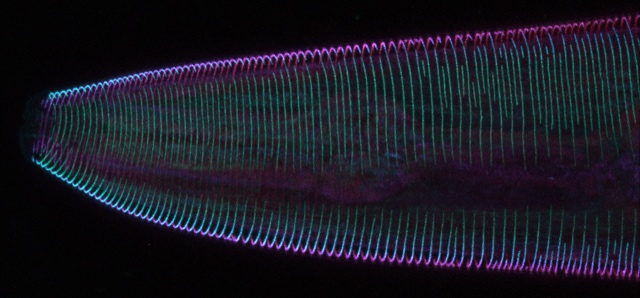Local organisation of synaptic proteome


Our work is a deep dive into the cell biology of neuron and C. elegans is well suited for this: neurons are conserved in metazoan evolution; Each neuron is extremely well characterised in C. elegans and easily observed through its transparent body. Several approaches are commonly used in the lab including forward genetics, -omics, biochemistry, optogenetics, behaviour, and quantitative cell biology.
Over the last few years, we generated a molecular atlas of C. elegans nervous system; We identified new and conserved genes controlling sensory functions, synaptic vesicle recycling and neuropeptide secretion; We observed ciliated sensory neurons release extracellular vesicles from their ciliated endings. In addition, we build a strong interest in understanding how neurons and circuits generate and maintain behaviour over their lifespan.
Learn more on our team's website here.
Contact Patrick LAURENT at patrick.laurent@ulb.be
NERVSPAN project
Presynaptic terminals contain clusters of dozen to thousands of Synaptic Vesicles (SV). These SV clusters are often seen as a reservoir of vesicles; but it can also be understood as a reservoir of presynaptic proteins. Many of the soluble proteins involved in processes such as exocytosis or endocytosis of SV are found in high concentrations within the presynaptic vesicle cluster, away from the plasma membrane where they are required. The mechanisms underlying the targeting, capture, and release of these proteins to and from the SV cluster remain enigmatic.
The SV cluster dynamically trap and mobilise SV according to synaptic activity. Similarly, we hypothesize that a dynamic protein assembly trap and release the proteins associated to the SV cluster. Our objective is to characterize and comprehend the mechanisms through which soluble proteins become targeted, captured, and released from the SV cluster during synaptic activity.
Objectives
In this project you will :- Identify the proteome of the SV cluster.
- Characterise the mobility of key synaptic proteins enriched in the SV cluster in controls and in mutants of reduced/increased SV exo/endocytosis.
- Define the impact of the relocation of selected protein onto the SV cycle and the synaptic function.
For this project we will make extensive use of C. elegans genetics (e.g. CRISPR and conditional protein depletion), biochemistry (proximity labelling) and advanced live-imaging techniques (FRAP and photoactivation microscopy as well as optogenetic controlled protein interaction studies). We collaborate with another lab developing a model of -liquid-liquid phase separation of SV with their SV-associated proteins in vitro.